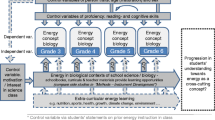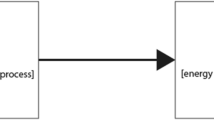Abstract
The aims of this cross-grade study were (1) to determine the level of understanding of energy concepts of students at different academic grades and the differences in understanding between these grades and (2) to analyse the conceptual development of these students. Two hundred and forty-three students at 3 different levels (high school, undergraduate, and postgraduate) participated in this study. The students’ understandings of energy concepts were determined using a questionnaire, which requested them to define the concept verbally, and to represent it graphically. The most important findings of this study may be summarised as follows. Students from the different groups generally succeeded in defining ‘energy’ in a similar way, namely as the ‘ability to do work’. Nevertheless, some students (including those at university) also provided different alternative conceptions related to the energy concept. In addition, some students also found difficulty in visually analysing the relationships between different variables using graphs. This finding could help explain why attainment levels of all groups falls short in questions that involve the graphical representation of data.

Similar content being viewed by others
References
Abraham MR, Williamson VM, Wetsbrook SL (1994) A cross-age study of the understanding of five chemistry concepts. J Res Sci Teach 31(2):147–165
Arcavi A (2003) The role of visual representations in the learning of mathematics. Educ Stud Math 52(3):215–241
Bishop AJ (1980) Spatial abilities and mathematics education: a review. Educ Stud Math 11(3):257–269
Boyes E, Stanisstreet M (1990) Pupils’ ideas concerning energy sources. Int Sci Educ 12(5):513–529
Brook AJ, Wells P (1988) Conserving the circus? An alternative approach to teaching and learning about energy. Phys Educ 23(2):80–85
Bui Thi KH (2005) Une étude didactique de la vie de l’energie dans l’enseignement de la Physique, en France et au Vietnam: Des décalages entre savoirs à enseigner au Lycée et savoirs de la formation universitaire, peuvent-ils être source de difficultés pour les enseignants? Unpublished PhD dissertation. University of Joseph Fourier, Grenoble, France
Çalık M, Ayas A (2005) A comparison of level of understanding of grade 8 students and science student teachers related to selected chemistry concepts. J Res Sci Teach 42(6):638–667
Chevallard Y (1989) Le concept de rapport au savoir. Rapport personnel, rapport institutionnel, rapport officiel. Actes du séminaire de Didactique des Mathématiques et de l’Informatique année 1988-1989, LSD-IMAG, Grenoble, 211–236
Diakidoy IAN, Kendeou P, Ioannides C (2003) Reading about energy: the effects of text structure in science learning and conceptual change. Contemp Educ Psychol 28(3):335–356
Dimitriadis P, Kabouris K, Karanikas J, Papamichalis K, Papatsimba L, Kalkanis G (1999) Linear motion study through graphs a new technology-based learning environnement. In: Proceedings of the 2nd international conference of the European Science Education Research, Kiel 31 August–4 September, 36–38
Domenech JL, Gil-perez D, Gras-marti A, Guisasola J, Torregrosa JM, Salinas J, Trumper R, Valdes P, Vilches A (2007) Teaching of energy issues: a debate proposal for a global reorientation. Sci Educ 16(1):43–64
Dreyfus T (1991) On the status of visual reasoning in mathematics and mathematics education. In: Furinghetti F (ed) Proceedings of the 15th conference of the International Group for the Psychology of Mathematics Education. Universita de Genova, Genova, pp 33–48
Duit R (1984) Learning to the energy concept in school—empirical results from the Philippines and West Germany. Phys Educ 19(2):59–66
Duit R (1987) Should energy be illustrated as something quasi-material? Int J Sci Educ 9(2):139–145
Duval R (1993) Registres de représentation sémiotique et fonctionnement cognitif de la pensée. Annales de Didactique et de Sciences Cognitives- IREM de Strasbourg 5:37–65
Duval R (1995) Sémiosis et pensée humaine. Registres sémiotiques et apprentissages intellectuels. Peter Lang, Berne
Elkana Y (1974) The discovery of the conservation of the energy. Hutchinson, London
Even R (1998) Factors involved in linking representations of functions. J Math Behav 17(1):105–121
Fry M, Dimeo L, Wilson C, Sadler J, Fawns R (2003) A new approach to teaching ‘energy and change’: using an abstract picture language to teach thermodynamic thinking in junior science classes. Aust Sci Teach J 49(1):36–43
Goldring H, Osborne J (1994) Students’ difficulties with energy and related concepts. Phys Educ 29(1):26–32
Gürdal A, Şahin F, Bayram H (1999) İlköğretim öğretmen adaylarının enerji konusunda bütünlüğü sağlama ve ilişki kurma düzeyleri üzerine bir araştırma. Dokuz Eylül University. J Buca Fac Educ 10:382–395
Haidar HA, Abraham MR (1991) A comparison of applied and theoretical knowledge of concept based on the particulate nature of matter. J Res Sci Teach 28(10):919–938
Heuvelen AV, Zou X (2001) Multiple representations of work-energy processes. Am J Phys 69(2):184–194
Hiebert J, Carpenter T (1992) Learning and teaching with understanding. In: Grouws DA (ed) Handbook of Research on Mathematics Teaching and Learning. Macmillan, New York, pp 65–97
Hırça N, Çalık M, Akdeniz F (2008) Investigating grade 8 students’ conceptions of ‘energy’ and related concepts. J Turk Sci Educ 5(1):75–87
Hitt F (1998) Difficulties in the articulation of different representations linked to the concept of function. J Math Behav 17(1):123–134
Hitt F (2002) Representations and mathematics visualization. Cinvestav-IPN, Mexico
Huis C, Berg E (1993) Teaching energy: a systems approach. Phys Educ 28(3):147–153
Kaper WH, Goedhart MJ (2002) Forms of energy, an intermediary language on the road to thermodynamics? Part I. Int J Sci Educ 24(1):81–95
Kemp HR (1984) The concept of energy without heat or work. Phys Educ 19(5):234–240
Köse S, Bağ H, Sürücü A, Uçak E (2006) Fen bilgisi öğretmen adaylarının canlılardaki enerji kaynaklarıyla ilgili görüşleri. Int J Envir Sci Educ 1(2):141–152
Kruger C, Palacio D, Summers M (1992) Surveys of English primary school teachers’ conceptions of force, energy and materials. Sci Educ 76(4):339–351
Küçük M, Çepni S, Gökdere M (2005) Turkish primary school students’ alternative conceptions about work, power and energy. J Phys Teach Educ 3(2):22–28
Kurnaz MA (2007) Üniversite 1. sınıf seviyesinde enerji kavramının öğrenim durumlarının analizi. Unpublished master’s dissertation, Karadeniz Technical University, Trabzon, Turkey
Kurnaz MA, Saglam Arslan A (2009) Using the anthropological theory of didactics in physics: characterization of the teaching conditions of energy concept and the personal relations of freshmen to this concept. J Turk Sci Educ 6(1):72–88
Lemmer M, Lemmer TN (2006) The role and place of energy in the physics curriculum. Paper presented at the GIREP 2006 conference: Modeling in Physics and Phys Educ, 20–25 Aug 2006, Amsterdam
Meltzer DE (2004) Investigation of students’ reasoning regarding heat, work, and the first law of thermodynamics in an introductory calculus-based general physics course. Am J Phys 72(11):1432–1446
Morgil I, Yoruk N (2006) Cross age study of the understanding of some concepts in chemistry subjects in science curriculum. J Turk Sci Educ 3(1):15–27
Nicholls G, Ogborn J (1993) Dimensions of children’s conceptions of energy. Int J Sci Educ 15(1):73–81
Papadouris N, Constantinou CP (2006) Design, development and validation of a teaching proposal for energy: results from a pilot implementation. Paper presented at the GIREP 2006 conference: Modeling in Physics and Phys Educ, 20–25 August 2006, Amsterdam
Papadouris N, Constantinou CP, Kyratsi T (2008) Students’ use of the energy model to account for changes in physical systems. J Res Sci Teach 45(4):444–469
Pell T, Jarvis T (2001) Developing attitude to science scales for use with children of ages from five to eleven years. Int J Sci Educ 23(8):847–862
Piez CM, Voxman MH (1997) Multiple representations-using different perspectives to form a clearer picture. Math Teach 90(2):164–166
Presmeg NC (2006) Research on visualization in learning and teaching mathematics. In: Gutiérrez A, Boero P (eds) Handbook of research on the psychology of mathematics education: Past present and future. Sense, Rotterdam, pp 205–235
Rowlands S, Graham T, Berry J, McWilliams P (2007) Conceptual change through the lens of Newtonian mechanics. Sci Educ 16(1):21–42
Saka A, Cerrah L, Akdeniz AR, Ayas A (2006) A cross-age study of the understanding of three genetic concepts: how do they image the gene, DNA and chromosome? J Sci Educ Technol 15(2):192–202
Sefton I (2004) Understanding energy. In: Proceedings of 11th biennial science teachers’ Workshop, 17–18 June 2004, University of Sydney
Séjourné A, Tiberghien A (2001) Conception d’un hypermédia en physique et études des activités des élèves du point de vue de l’apprentissage. Actes du Cinquième Colloque Hypermédias et Apprentissages, Grenoble
Tairab HH, Al-Naqbi AK (2004) How do secondary school science students interpret and construct scientific graphs? J Biol Educ 38(3):127–132
Trigueros M, Martínez-Planell R (2009) Geometrical representations in the learning of two-variable functions. Educ Stud Math, Published online 24 June 2009
Trowbridge JE, Mintzes JJ (1988) Alternative conceptions in animal classification: a cross-age study. J Res Sci Teach 25(7):547–571
Trumper R (1990) Being constructive: an alternative approach to the teaching of the energy concept, part one. Int J Sci Educ 12(4):343–354
Trumper R (1991) Being constructive: an alternative approach to the teaching of the energy concept, part two. Int J Sci Educ 13(1):1–10
Trumper R (1998) A longitudinal study of physics students’ conceptions on energy in pre-service training for high school teachers. J Sci Educ Technol 7(4):311–318
Trumper R, Gorsky P (1993) Learning about energy: the influence of alternative frameworks, cognitive levels, and closed-mindedness. J Res Sci Teach 30(7):637–648
Ünal Çoban G, Aktamış H, Ergin Ö (2007) İlköğretim 8. Sınıf Öğrencilerinin Enerjiyle İlgili Görüşleri. Gazi University. J Kastamonu Fac Educ 15(1):175–184
Van Den Berg E, Van Den Berg R, Capistrano N, Sicam A (2000) Kinematics graphs and instant feedback. Sch Sci Rev 82:104–107
Warren JW (1982) The nature of energy. Eur J Sci Educ 4(3):295–297
Warren JW (1983) Energy and its carriers: a critical analysis. Phys Educ 18(5):209–212
Watts DM (1983) Some alternative views on energy. Phys Educ 18(5):213–217
Westbrook SL, Marek EA (1992) A cross-age study of student understanding of the concept of homeostasis. J Res Sci Teach 29(1):51–61
Author information
Authors and Affiliations
Corresponding author
Rights and permissions
About this article
Cite this article
Saglam-Arslan, A. Cross-Grade Comparison of Students’ Understanding of Energy Concepts. J Sci Educ Technol 19, 303–313 (2010). https://doi.org/10.1007/s10956-009-9201-3
Published:
Issue Date:
DOI: https://doi.org/10.1007/s10956-009-9201-3




